Myths and truths behind Mercury retrogrades
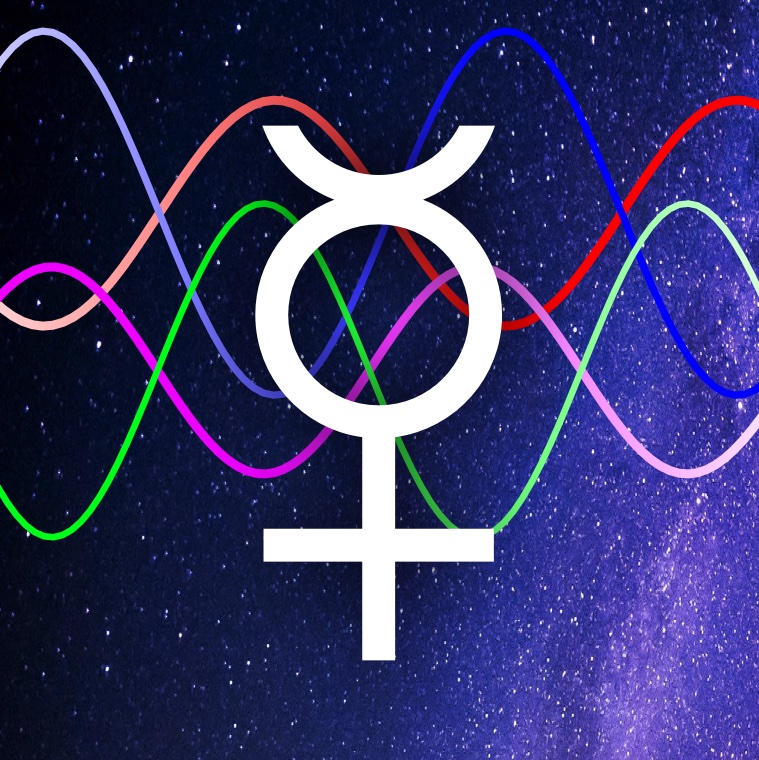
While every planet goes retrograde, it’s Mercury that captures our attention the most. Periods of Mercury retrograde movement are known to coincide with disruptions in communications — both human and technological connections tend to go haywire in a predictably unexpected manner. What makes Mercury retrogrades so special?
One may argue that from a human perspective it’s Mercury, not the Moon, that is the most “relatable” of all celestial bodies. As much as the Moon is the most inconspicuous of all planets, its actions belong to predominantly unconscious depths of human emotional and physiological domain, and while we are regularly experiencing the effects of the Moon’s influence we are hardly ever capable of truly operating at that extremely subtle and nuanced level.
On the other hand, the energies of Mercury are quite literally the source of our daily “bread and butter”. All kinds of human activity rest on communication — we are social creatures that harness the power of interpersonal exchange to fulfil a vast variety of daily tasks.
No other planetary archetype provides us with so much practical skills than Mercury does. Our interaction with the Mercurial domain is perhaps the most conscious of all interactions. That is why the symbol of a young winged Mercury is so universally loved and related to.
Perhaps it’s that intuitive closeness that projects the periods of Mercury retrograde into the spotlight of human awareness, highlighting our genuine worries and insecurities. Should it really be like that? We will attempt to answer this question.
Mercury deals with trade and boundaries
In order to get a better understanding of Mercury energies, one needs to look at Mercury as the governing principle behind all kinds of exchanges. It is worth noting that Mercury is the Roman equivalent of the Greek god Hermes.
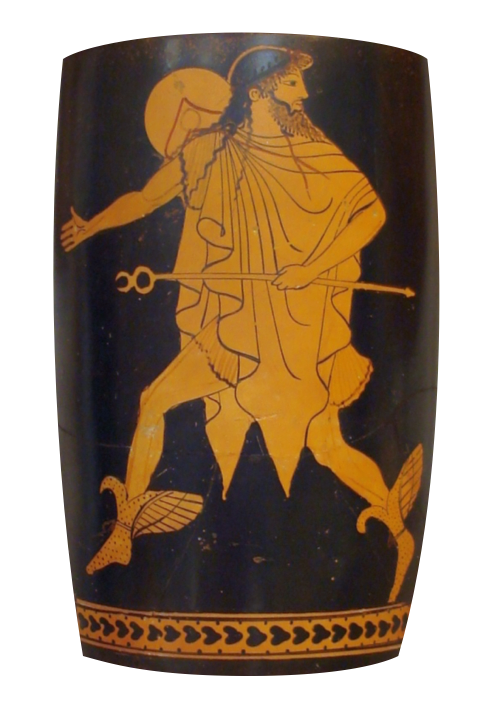
The herald Mercury,
New-lighted on a heaven-kissing hill.
W. Shakespeare
Image: One dead president, David Liam Moran [CC BY-SA 3.0], via Wikimedia Commons
The name Hermes is thought to originate from Greek “herma” (ἕρμα), the word that describes a heap of stones that serves as a boundary marker. While down on Earth Hermes was revered as the swift god of travellers, his primary celestial function was the one of the messenger of the gods as nominated by Zeus himself in recognition of Hermes’ equally ingenious skills in negotiation and trickery.
Young Hermes was not only able to steal sacred oxen from his half-brother Apollo, the solar god, he was also able to trade them back while earning a good profit. This impressive negotiation skill set became the hallmark quality of Hermes on Earth where he was also recognised as the god of both merchants and thieves.
In Roman culture Hermes became known as Mercury — the name possibly originated from the Latin word “merx” that means merchandise and commerce, or alternatively from a more ancient root “merĝ-“ that stands for boundary or border.
The domain of commerce, trade and messaging is governed by the energies of Mercurial nature. Most of trade implies the existence of boundaries and the exchange of merchandise and finance that flows across clearly demarcated areas of influence.
Not unlike seasons of the nature, trade and commerce follow the principle of cycles of expansion and contraction separated by periods of standstill and equilibrium. With its retrograde movement Mercury introduces another quality, the one of recharge through internalisation. Before going further into this mysterious process, let’s first clear up the notion of a retrograde movement.
What is a Mercury retrograde movement?
Simply put, a retrograde movement happens during a period of time when the planet visually moves in the direction opposite to its normal progression. The retrograde effect is of a purely visual nature. The planet still moves in the same direction but at some segments of its elliptical orbit the Earth “overtakes” that planet producing an illusion of the planet slowing down and reversing. That’s pretty much what each of us regularly experiences watching other cars while driving on a highway — the visual trick of relative speeds.
When it comes to retrogrades, Mercury is the most prolific of all planets. This fact highlights the special relationship between Mercurial energies and the know how of alternating between the movement of externalisation and the one of internalisation.
Mercury is the swiftest planet of all and the closest to the Sun — thus Mercury goes retrograde fairly often. At any given year we experience 3–4 retrograde Mercury periods of about 21 days each.
What is the opposite of retrograde?
The opposite of retrograde is the “normal” direction of planetary movement that is traditionally called direct. There is also a newer trend that uses the word “prograde” instead of direct. Time Nomad sticks to the traditional astrological parlance and therefore uses the word direct as the opposite to retrograde.
We believe that “direct” is a more symbolically correct term, it clearly conveys the direct nature of expression of planetary energies.
The symbol of caduceus and the occult forces of Mercury
The famous symbol of Mercury is his staff called the caduceus that comes from Latin “cādūceus” that in its turn comes from Greek kērū́keion (κηρύκειον) meaning “herald’s wand”. Hermes–Mercury received his staff in his famous trade deal with his half-brother Apollo.

The caduceus carries a rich symbolism that can be read in several ways:
- it represents the power of mediation and diplomacy that achieves balance between two opposing forces (the two entwined snakes)
- it suggests the power of transformation between two genders
- it expresses the ever oscillating rhythm of time and changing circumstances
- it separates the world of living from the world of dead
- it carries an uncanny resemblance to the DNA double helix
This expressive symbol brings us closer to revealing another important function of Mercury — the initiator into hidden mysteries.
Mercury has the powers to move from the world of visible to the world of invisible, it is the interfacing principle between life and afterlife. The guidance of the dead is one of its primary functions that reveals the true depth of occult forces that it possesses.
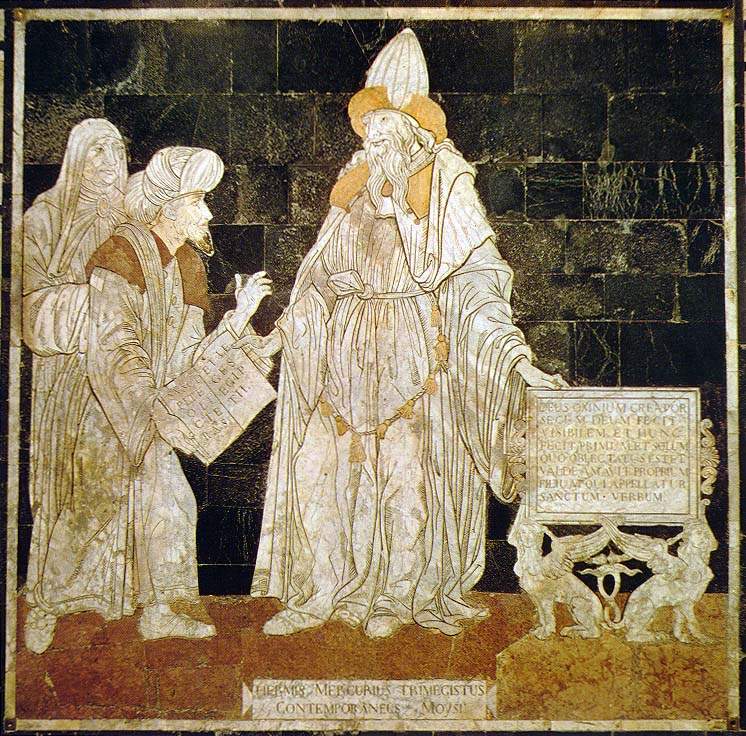
Mercury controls transitions
Turned on its side, the caduceus offers further clues to the nature of Mercurial energies.
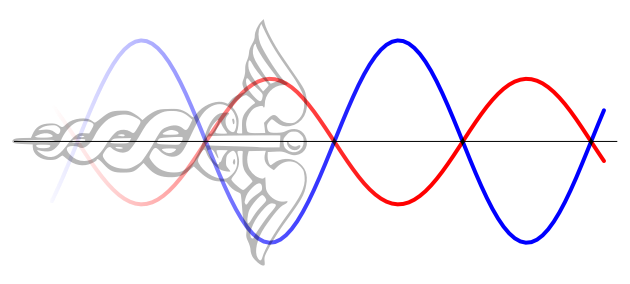
The two oscillating sinusoidal waves point at the powers that control transition between visible and invisible, external and internal.
Even though Saturn is the ultimate measurer of time, Mercury embodies the function of regulating the passage through time crossings and pivotal moments. This function if well visible in this illustration borrowed from earlier story “What is Planetary Hours, part 2”.
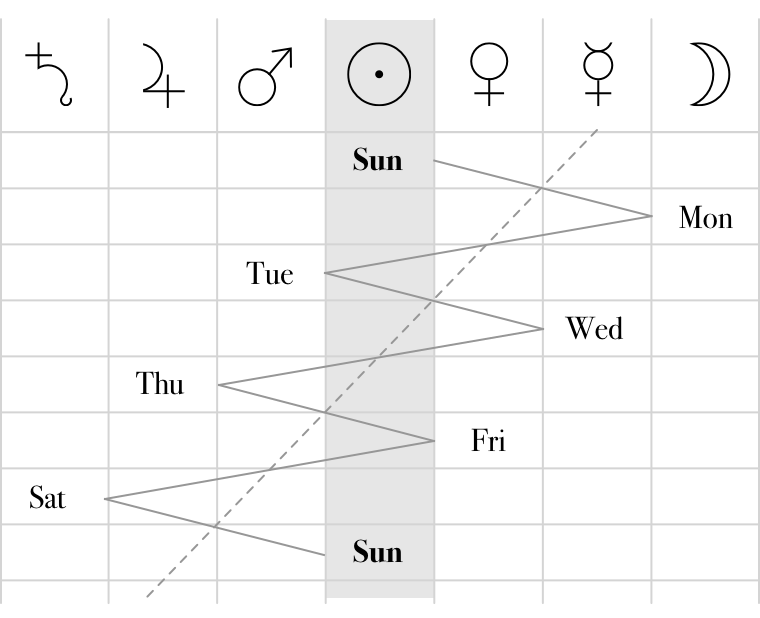
The caduceus principle is easily recognisable in this graph of the sequence of the days of the week. Mercury is not only the “axis” along which the unfoldment of time is happening, Mercury controls crossings between periods of time.
The highly regular nature of Mercury retrograde movement periods is yet another hint at its regulating function known since ancient times — statues of Mercury were often placed at the crossroads symbolising its helping influence on travellers and merchants as well as its domain crossing know how.
Mercury is eternally young and transgender
No story about Mercury omits its sweet looks and its omnipresent wings. The sense of lightness and agility is equally the symbol of eternal youth as well as profound degree of fluidity that Mercury, both the god and the metal, possess.
While all classical planets have a clear masculine/feminine separation, it’s never that simple with Mercury who’s nature is equally male and female. We have previously discussed the notion of gender in the story called “Masculine, feminine and transgender in astrology“.

Mercury is androgynous, transsexual and transgender. Mercury is perfectly able to embody both sexual polarities and artfully transcend the boundary between the sexes.
The caduceus yet again symbolises the process of unification and removal of the male/female opposition in favour of a more integrated male–female nature that is, according to some esoteric writers, the distant future when humanity will be able to rectify the painful split caused by the separation of sexes and the resulting feeling of being inherently incomplete, forever seeking (and never finding) the mythical second half.
The male/female split is also one of major factors that contribute to the processes behind ageing. There is a symbolical promise in the image of forever youthful lightweight Mercury and the keys that it holds!
Internalisation during Mercury retrograde
Mercury also controls mental processes, it gives the ability to think rationally, provides with creative intuition that connects ideas with reality.
During retrograde periods Mercurial function of the mind is turned inwards. Those periods are of great value for their qualities of introspection, careful planning and strategising. Ideas and thoughtfully crafted intentions of the retrograde period can manifest in more solid outcomes once Mercury is back to its direct course.
On the occult side of things, it is believed that when the mind is equipped with Hermetic knowledge, it is capable of piercing behind the veil that separates the invisible domain of causes from the visible world of consequences. Thus retrograde periods are great time windows to penetrate the fabric of reality and witness the unfoldment of the universe itself and your personal role in this process. That is certainly easier said than done… yet the Hermetic science is there, the gifted and curious ones can be trained in that discipline.
Typical mistakes handling Mercury retrograde
What are the pitfalls and outright superstitions that make a Mercury retrograde more confusing that it should be? Below is the summary of effective strategies that help us better navigate through retrograde periods.
Oversimplification
Popular advices along the lines that “Mercury retrograde means emails may not arrive” or “Don’t go for job interviews or engage in any kind of negotiations” serve little justice to the real significance of Mercury retrogrades.
Mercury retrograde is not the time for superstitious avoidance. Quite the opposite, your intellect is capable of looking deeper and analyse the situation better. Use this opportunity to ponder upon your questions before rushing into action. There is a power of insight at your disposal.
Don’t do attitude
Mercury retrograde is not about avoiding making decisions, purchases or launching new initiatives. There are countless examples of successful actions that took place during Mercury retrograde periods.
Those periods are more about doing the right thing rather than assuming a “head in the sand” position. The right thing is to follow the internalising flow of Mercury and discover the deeper facts and truths, about yourself and the people around you.
Fatalistic approach
Any disconnect or communication breakdown that will happen is due to happen because of inherent instability that has not been recognised, the flaws in the system design.
Being overly cautious will not mitigate those deeper issues. What helps though is performing simple and direct tasks that belong to the “here and now” domain of Mars-inspired action. It is a good time to shift one’s focus from the terrain of the mind full of potential convolutions to the domain of physicality and simplicity.
Underestimating the power of disconnects
And finally, one thing is clear about Mercury retrogrades, that is no matter how well prepared one may attempt to be — duplicate everything possible, avoiding certain actions, etc. — the retrograde effect will appear along the fault line that one doesn’t know yet. That is the nature of events that bubble up from the domain of unseen to the world of consciousness.
Discovering why something happened may not be an easy task. Yet there is a certain truth behind those “malfunctions”. Events that happen during Mercury retrogrades are often the precursors of bigger trends, they are the first symptoms and a great help in predictive astrological work!
3 Comments
Mahjabeenjawad
I like the symbolism of Hermes behind mercury which I was ignorant about before reading this article very informative wants to learn more
Alex Randall
Seems to me that Mercury is associated with health care.
Time Nomad
Or it can be said that healthcare has affinity with Mercury / Hermes. The Hermetic tradition is the tradition of healing hence the association.